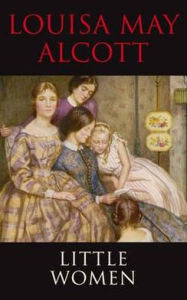by Sandra Merville Hart
I was a teenager the first time I read Louisa May Alcott’s Little Women. A childhood friend came in just as I sobbed over a tragic part of the story. I’ve read the novel at least a dozen times since that summer day.
Characters in the novel were inspired by Louisa’s own family and friends. Knowing her characters so well deepened the portrayal of them, evoking an emotional response in her readers.
*** Spoiler alert *** If you haven’t read the novel and intend to, you may want to read this post afterward as there are a few spoilers.
There are three reasons that I cry every time I read Little Women: believable family relationships; unexpected romances; and twists that mirror life.
Loving family relationships blanket the story. The reality of the Civil War touches the family. Jo’s father serves as a Union chaplain and is away at war. Jo and her sister, Meg, take jobs to support the family. When the story opens, another sister, Beth, helps the mother at home while the youngest, Amy, attends school.
But life gives them a terrible twist—Beth helps a family where three children suffer from scarlet fever and falls ill herself. She recovers from scarlet fever but her health is never the same. Eventually readers realize that she will die.[bctt tweet=”The twists and turns of Alcott’s classic novel mirror life. #writing” username=”@Sandra_M_Hart”]
The second reason I cry when reading this classic novel is the unexpected romances. We watch Laurie, the family’s neighbor, fall in love with Jo and really want them to marry.
Though readers believe that Jo and Laurie are made for each other, a twist comes. Jo accepts a position as governess to a family in New York City. Professor Bhaer, who resides at the same boarding house, teaches German to Jo. He also critiques her writing. His disappointment in her stories cuts deeply. He encourages her to write stories with a moral.
What writer can’t relate to her pain?
Jo spends six months in New York before returning home to care for her gravely ill sister. Laurie finally proposes as anticipated, but Jo rejects him. Sad and angry, he travels to Europe. Neither of these events is what readers expect.
Another twist is coming. Jo’s youngest sister, Amy, is in Europe where she’s being courted by Laurie’s rich school friend, Fred. Readers are surprised to watch Amy fall in love with Laurie. Fred seems to be the better choice for Amy at first because Laurie is an angry, bitter man. He wakes up in time to realize Amy is the woman for him. They marry while in Europe.
What! Readers believed that Laurie was intended for Jo.
Meanwhile, Jo has all the sorrow she can handle. She tends to Beth as her little sister loses strength to even lift a needle to sew. Jo’s heart breaks—and ours with hers—when Beth dies.
As the family celebrates Amy’s marriage, Professor Bhaer arrives. In yet another twist to the story, he proposes and Jo happily accepts.
This leads to the third reason I always cry when reading Little Women: the twists and turns of the novel mirror life. The changes, the heartaches, and the bumps in the road feel realistic to readers—after we recover from shock and disappointment. Can’t we all relate to choosing a path leading one place and then ended up on completely different road?
Louisa’s publisher approached her in 1868 with a request to write a book about girls. She initially resisted. She finally gave in to urging from her publisher and her father. Then she set her novel in a house modeled after her home with characters inspired by family and friends.
The novel she didn’t want to write became a beloved classic and brought her financial independence.
Readers through the ages have reason to rejoice that Louisa listened to the urging of her publisher.
Sources
“Little Women,” Wikipedia, 2017/03/25 https://en.wikipedia.org/wiki/Little_Women.
“Louisa May Alcott,” Biography.com, 2017/03/25 http://www.biography.com/people/louisa-may-alcott-9179520.






3 Comments
[…] Women, a dozen times over the years. The novel always touches my heart. Find out why in my post on Almost an […]
I once met a woman named Amy who told me this story. When her mother was a little girl, she made a pact with three friends to name their first daughters after a major character in this story. Meg, Jo, and Beth had already been born, and although Amy’s mother didn’t care for the name, she felt obligated to finish the quartet. And that’s how Amy became Amy.
Another memory is of visiting Alcott’s Massachusetts home with my mother. A girl of about 11 was on the same tour along with her grandparents. In every room, after every sentence the tour guide uttered, she would ask a question. The poor girl was so disappointed that each episode of the novel wasn’t an exact mirror of Louisa May Alcott’s real life. We enjoyed the little girl’s questions more than seeing Alcott’s personal effects.
Thanks for this fun read.
Thank you, Holland! There’s a long list of things we think we’ll do as adults, but it sounds like that mom followed through on her promise. 🙂 I’ve not visited the Alcott home, but I thought it was very clever to use familiar surroundings in the novel. So glad my post took you down memory lane.